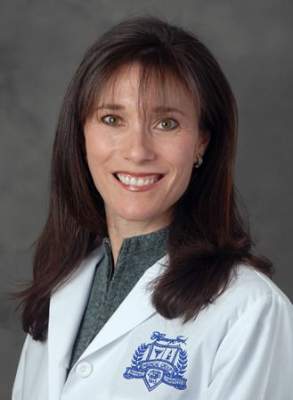User login
MIAMI BEACH – A fixed-dose adapalene/benzoyl peroxide gel is a suitable treatment for acne in adult women, according to a meta-analysis of data from three randomized, vehicle-controlled multicenter studies.
The median percent change in total lesions at 12 weeks in 130 women who were treated with the 0.1% adapalene/2.5% benzoyl peroxide gel (A-BPO) was –71%, compared with –45% in 124 treated with vehicle gel, Dr. Linda Stein Gold of Henry Ford Medical Center, Detroit, reported in a poster at the annual South Beach Symposium.
Similarly, the median percent change in inflammatory lesions was –73% vs. –41%, and the median percent change in noninflammatory lesions was –70% vs. –45% in the groups, respectively.
Response to the A-BPO treatment was rapid, with significant improvements seen at 1 week, compared with vehicle. Treatment was also well tolerated; adverse events occurring in at least 3% of those in the A-BPO treatment group were dry skin, contact dermatitis, and application site irritation, but all were mild, Dr. Gold noted.
Study participants were women aged 25 years and older. Data increasingly demonstrate that the prevalence of acne in women in this age group is increasing, with up to 54% of women affected, she said.
“Furthermore, recent data show that the mandibular form of acne traditionally associated with adult women is less prevalent than previously thought and that most acne in adult women more closely resembles adolescent acne,” she wrote.
Treatment with benzoyl peroxide in combination with a retinoid has been recommended as a first-line treatment for women with acne, and the fixed-dose A-BPO combination used in this study has been shown to be safe in patients as young as age 9 years.
The findings of this meta-analysis suggest that it is also effective and safe – with quick onset of action – in adult women, she concluded.
This study was funded by Galderma Research and Development and Galderma Laboratories.
MIAMI BEACH – A fixed-dose adapalene/benzoyl peroxide gel is a suitable treatment for acne in adult women, according to a meta-analysis of data from three randomized, vehicle-controlled multicenter studies.
The median percent change in total lesions at 12 weeks in 130 women who were treated with the 0.1% adapalene/2.5% benzoyl peroxide gel (A-BPO) was –71%, compared with –45% in 124 treated with vehicle gel, Dr. Linda Stein Gold of Henry Ford Medical Center, Detroit, reported in a poster at the annual South Beach Symposium.
Similarly, the median percent change in inflammatory lesions was –73% vs. –41%, and the median percent change in noninflammatory lesions was –70% vs. –45% in the groups, respectively.
Response to the A-BPO treatment was rapid, with significant improvements seen at 1 week, compared with vehicle. Treatment was also well tolerated; adverse events occurring in at least 3% of those in the A-BPO treatment group were dry skin, contact dermatitis, and application site irritation, but all were mild, Dr. Gold noted.
Study participants were women aged 25 years and older. Data increasingly demonstrate that the prevalence of acne in women in this age group is increasing, with up to 54% of women affected, she said.
“Furthermore, recent data show that the mandibular form of acne traditionally associated with adult women is less prevalent than previously thought and that most acne in adult women more closely resembles adolescent acne,” she wrote.
Treatment with benzoyl peroxide in combination with a retinoid has been recommended as a first-line treatment for women with acne, and the fixed-dose A-BPO combination used in this study has been shown to be safe in patients as young as age 9 years.
The findings of this meta-analysis suggest that it is also effective and safe – with quick onset of action – in adult women, she concluded.
This study was funded by Galderma Research and Development and Galderma Laboratories.
MIAMI BEACH – A fixed-dose adapalene/benzoyl peroxide gel is a suitable treatment for acne in adult women, according to a meta-analysis of data from three randomized, vehicle-controlled multicenter studies.
The median percent change in total lesions at 12 weeks in 130 women who were treated with the 0.1% adapalene/2.5% benzoyl peroxide gel (A-BPO) was –71%, compared with –45% in 124 treated with vehicle gel, Dr. Linda Stein Gold of Henry Ford Medical Center, Detroit, reported in a poster at the annual South Beach Symposium.
Similarly, the median percent change in inflammatory lesions was –73% vs. –41%, and the median percent change in noninflammatory lesions was –70% vs. –45% in the groups, respectively.
Response to the A-BPO treatment was rapid, with significant improvements seen at 1 week, compared with vehicle. Treatment was also well tolerated; adverse events occurring in at least 3% of those in the A-BPO treatment group were dry skin, contact dermatitis, and application site irritation, but all were mild, Dr. Gold noted.
Study participants were women aged 25 years and older. Data increasingly demonstrate that the prevalence of acne in women in this age group is increasing, with up to 54% of women affected, she said.
“Furthermore, recent data show that the mandibular form of acne traditionally associated with adult women is less prevalent than previously thought and that most acne in adult women more closely resembles adolescent acne,” she wrote.
Treatment with benzoyl peroxide in combination with a retinoid has been recommended as a first-line treatment for women with acne, and the fixed-dose A-BPO combination used in this study has been shown to be safe in patients as young as age 9 years.
The findings of this meta-analysis suggest that it is also effective and safe – with quick onset of action – in adult women, she concluded.
This study was funded by Galderma Research and Development and Galderma Laboratories.
Key clinical point: Adapalene/benzoyl peroxide gel is safe and effective for acne in adult women.
Major finding: Mean percent change in total lesions at 12 weeks with adapalene/benzoyl peroxide gel vs. vehicle: –71% vs. –45%.
Data source: A meta-analysis of three studies involving 254 women.
Disclosures: This study was funded by Galderma Research and Development and Galderma Laboratories.

